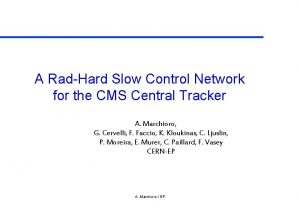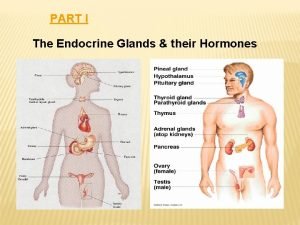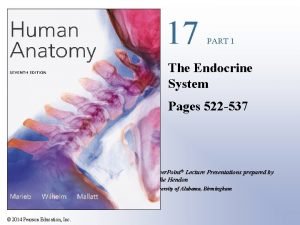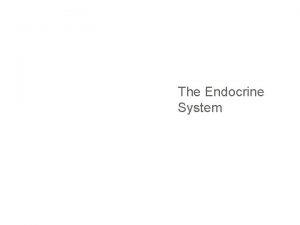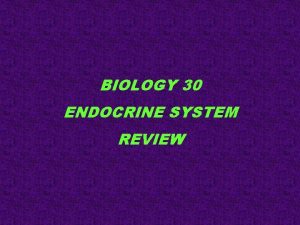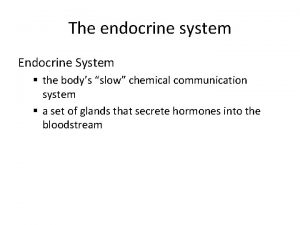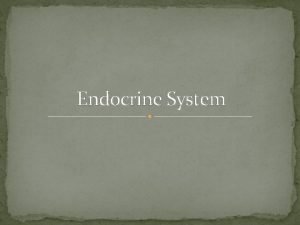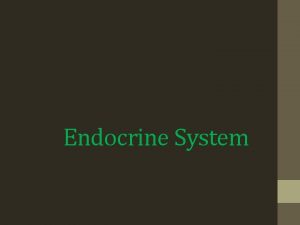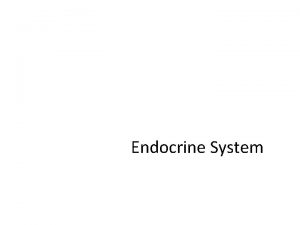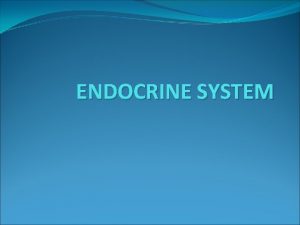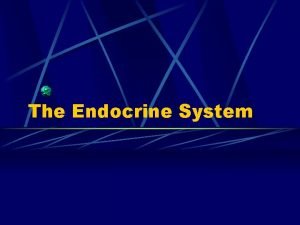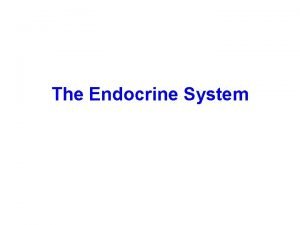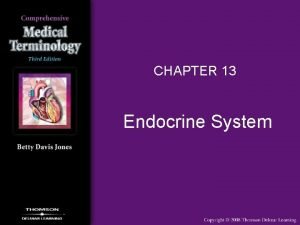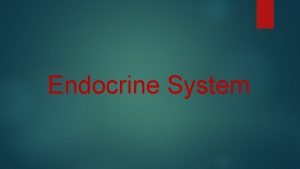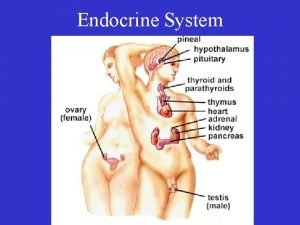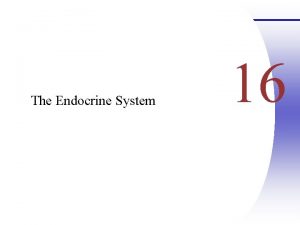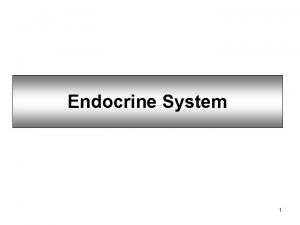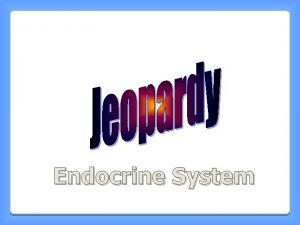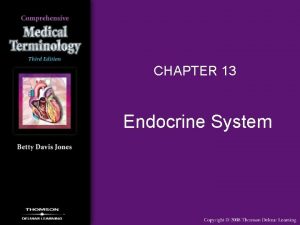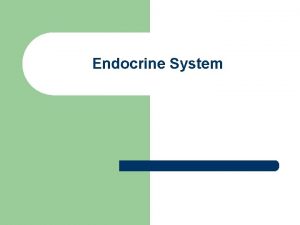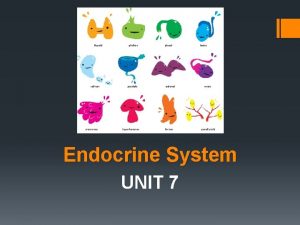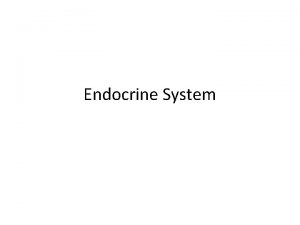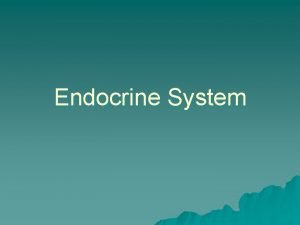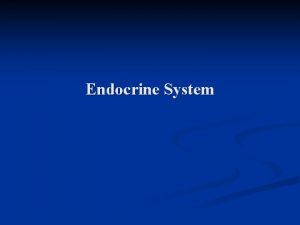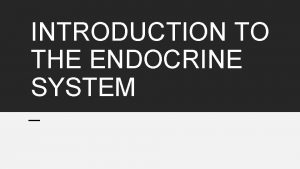Endocrine System The slow control The Endocrine System

























- Slides: 25

Endocrine System The slow control

The Endocrine System Overview Nervous vs. Endocrine… What are endocrine cells (glands)? �� Structures that release chemical messengers (hormones) into blood vessels to reach target cells in other tissues

Endocrine System - Hormones What is the make up of hormones? Amino acid basis Examples: Epinephrine & norepinephrine, thyroxine & triiodothyronine (T 4 & T 3), melatonin… Peptide basis Short chains of amino acides Examples: ADH, PRL, Oxytocin, HGh, prolactin… Lipid basis Eicosanoids prostaglandins Steroid hormones Testosterone & estrogen

Endocrine System – Hormonal Action • How do hormones do their thing? – via signal transduction – Mechanism of signal transduction depends on the type of hormone • Lipid Soluble Vs. Water Soluble Binding sites are on cell surface Binding sites are intracellular 1. Hormone (primary messenger) binds to membrane receptor 1. Hormones diffused through plasma membrane and bind to receptors 2. Receptor either opens a channel, activates a secondary messenger, or an enzyme 2. Gene activity is altered! 3. Secondary messenger alters metabolic events of cell

Hormone Action lipid soluble vs. water soluble actions

Hormone Interaction • Hormones may function alone, but also may be influenced by other hormones, this interaction may be – Antagonistic • These have opposite effects – Synergistic • These hormones work with others to achieve full effect – Permissive • These hormones action “permits” or sets the stage for another hormone to achieve full effect

Endocrine System – Control • Hormone levels are controlled almost entirely by negative feedback loops –The hypothalamus plays an integral role in endocrine regulation • Recall: hypothalamus is part of the diencephalon and therefore provides a link between nervous and endocrine system • Three mechanisms of hypothalamic regulation of the endocrine system 1. Secretion of regulatory hormones (releasing and inhibiting hormones) to control other glandular actions 2. Synthesis of ADH and oxytocin by neuronal cell bodies in the hypothalamus that terminate in the posterior pituitary 3. ANS control of the adrenal medulla via sympathetic nerves.

Endocrine System - Glands • The Pituitary Gland (aka hypophysis) • Divided into two portions – Anterior pituitary (adenohypophysis) • Communicates with he hypothalamus via blood vessels (hypophyseal portal system) that travel in the infundibulum – Posterior pituitary (neurohypophysis) • Contains axon terminals from they hypothalamus – Release neurotransmitters from synaptic bulbs that then enter circulation

Endocrine System – Glands • Hypothalamus – Pituitary Relationship

Endocrine System - Glands • The Anterior Pituitary (adenohypophysis) – Contains seven centers or clusters of cells that produce hormones • Four control secretions of hormones from other glands are called tropic hormones • Three target tissues directly • Secretion is controlled by releasing (RH) and inhibiting (IH) hormones from the hypothalamus

Anterior Pituitary – Tropic Hormones • ACTH (adrenocorticotropic hormone) – Stimulates the adrenal cortex to produce glucocorticoids that regulate glucose balance – Controlled by circulating levels of glucocorticoids • Increase in glucocorticoids causes a decrease in production of CRH (corticotropic releasing hormone) from the hypothalamus as well as a decrease directly in the production of ACTH from the anterior pituitary

Anterior Pituitary – Tropic Hormones • TSH – Thyroid stimulating hormone or thryrotropin – Targets the thyroid gland follicles – Increases production of thyroid hormones (thyroxine & triiodothyronine – T 4 & T 4) – Controlled by circulating levels of thyroid hormones, an increase causes a decrease in production of TSH and TRH (thyrotropin releasing hormone) from they hypothalamus • Negative feedback loop

Anterior Pituitary – Tropic Hormones • FSH (Follicle Stimulating Hormone) – Female: • Starts follicular development in the ovary which increases production of estrogen – Male: • Supports sperm development in testes • LH (Lutinizing Hormone) – Secretion of LH will start ovulation and promotes secretion of progesterone – In males, LH (aka interstitial cell-stimulating hormone) stimulates interstitial cells to produce testosterone

Anterior Pituitary – Non-tropic Hormones • PRL (Prolactin) – Female: • Synergistic hormone involved in mammary gland development and milk production – Male: • May be involved in androgen production ? ? ? • MSH (Melanocyte Stimulating Hormone) – Not normally found in measurable amounts in adult humans – May play a role in embryonic development

Anterior Pituitary – Non-tropic Hormones • h. GH (human Growth Hormone) – Most cells respond by increasing rate of cell growth and protein production – effects are by indirect and direct stimulation – Indirect – in response to GH, liver cells synthesize and release insulin-like growth factors (IGF’s) • The IGF’s increase amino acid uptake and subsequent protein synthesis • Utilized after a meal when circulating nutrient levels are high – Direct – not as well understood, but occurs after blood levels of glucose & amino acids has returned to normal • In epithelial tissues and some connective tissues, h. GH increases stem cell division and subsequent daughter cell reproduction • In adipose tissue the adipocytes are stimulated to break down stored lipids which increases lipid use for energy (glucose sparing effect of h. GH)

Endocrine Glands – Posterior Pituitary • The Neurohypophysis contains – Clusters of neurons near the optic chiasma and next to the ventricles in the hypothalamus produce hormones that are then released at their synaptic bulbs in the posterior pituitary • ADH (antidiuretic hormone, aka vasopressin) – Secreted when » Blood osmolarity increases » Blood volume or pressure decreases – Effects » Vasoconstriction » Water reabsorption • Oxytocin – Hormone of childbirth » Affects both uterus and mammary glands – Also involved in the sexual response of males and females

Endocrine Glands – Thyroid • Location & Shape: – Anterior to the trachea, inferior to the larynx – Bow-tie shape with the “bows” linked by an isthmus • Function: – Production of thyroid hormones (T 3 & T 4) • From thyroid follicles under stimulation by TSH – Production of calcitonin (CT) • From cells around the thyroid follicles (parafollicular cells)

Endocrine Glands - Thyroid Parafollicular Cells • Thyroid Hormone Production: – Within thyroid follicles T 4 T 3 T 4 • Think of them as water balloons – The balloon skin made of follicular cells – The water inside is called the colloidal fluid (substance) Colloid T 3 T Follicular Cells • Allows them to be regulated - why? – T 4 (thyroxine) & T 3 (triiodothyronine) • Derived from the amino acid tyrosine with 3 or 4 iodine molecules added • Bind to mitochondria and DNA, increase cell metabolism via a calorigenic effect 4

Endocrine Glands – Thyroid • The parafollicular cells produce calcitonin (CT) – Function • Inhibit the activity of osteoclasts • Increase Ca 2+ excretion from the kidneys • Reduce Ca 2+ absorption in the GI – Control • Blood levels of calcium

Endocrine Glands – Parathyroid • Location: – Posterior side of thyroid gland on the superior and inferior lobes • Function: – Secretion of PTH (parathyroid hormone) • Drop of blood calcium levels triggers a release of PTH which activates osteoclasts and increases the production of calcitriol in the kidneys, this increases the level of Ca 2+ and PO 43 - absorption in the GI tract

Endocrine Glands - Adrenal • Location & Shape: – Pyramidal in shape, located above the kidneys (suprarenal) • Structure: – Inner medulla • Controlled by the sympathetic division of the ANS – Outer cortex – three regions • Deep – secretes androgens (sex hormones) • Middle – secretes glucocorticoids – Cortisol, corticosterone, cortisone are the main hormones » Increase rate of glucose synthesis and glycogen formation » Anti-inflammatory (common active ingredient in anti-itch creams) • Outer – secretes mineralocorticoids – Aldosterone is the main hormone from the outer zone of the cortex and increases conservation of Na+ and elimination of K+

Endocrine Glands - Pineal • Location & Shape: – Epithalamus, posterior and superior to the third ventricle • Endocrine Function: – Production and secretion of melatonin • Involved with regulation of day/night cycles (circadian rhythms) • Also may be involved with – Inhibition of maturation of the reproductive system – Protection of CNS via antioxidant activity

Endocrine Glands - Pancreas • Location & Shape: – Located in the curvature created by the inferior curvature of the stomach, and the curvature of the duodenum • Function: – Endocrine function is to produce and secrete insulin from Beta cells, and glucagon from Alpha cells • Insulin causes an increase in the uptake of glucose by cells • Glucagon causes an increase in glycolysis, and gluconeogenesis by the liver – Also secretes somatostatin • Regulates activity of alpha and beta cells

Endocrine Glands - Gonads • Ovaries – Produce: • estrogen & progesterone – due to the effects of FSH on the follicles of the ovary – Involved in preparation and maintenance of the uterus • Inhibin & Activin – secreted by gonads as well as placenta – Inhibin – inhibits FSH – Activin – increases FSH production • Testes – Produce testosterone, inhibin • Testosterone by interstitial cells (cells of Leydig) • Inhibin secreted by sertoli cells & inhibits FSH

Miscellaneous Endocrine Tissues • GI tract – Various hormones are secreted to control secretion and motility with the GI tract • Kidneys – Secretes calcitriol (increases Ca 2+ absorption) and EPO (erythropoeitin) which increases RBC production in red bone marrow – Secretes renin, which targets angiotensinogen to start the reninangiotensin system to regulate blood volume and pressure • Heart – Secretes ANP (atrial natriuretic peptide) • Causes reduction of blood volume and therefore blood pressure • Thymus – Secretes thymosins which are needed early in development for proper functioning of the immune system
 Slow in slow out animation
Slow in slow out animation Antefact
Antefact Slow control application
Slow control application Mechanisms of hypothalamic control over endocrine function
Mechanisms of hypothalamic control over endocrine function Endocrine system and reproductive system
Endocrine system and reproductive system Endocrine system vs nervous system
Endocrine system vs nervous system Lymphatic system vs endocrine system
Lymphatic system vs endocrine system Amino acid-based hormones
Amino acid-based hormones Adh function
Adh function Slow chemical communication system
Slow chemical communication system Chapter 16 matching questions 1-5
Chapter 16 matching questions 1-5 Parts of the endocrine system
Parts of the endocrine system Differences between nervous system and endocrine
Differences between nervous system and endocrine Comparison of endocrine and nervous system
Comparison of endocrine and nervous system Endocrine molecules
Endocrine molecules Facts about the endocrine system
Facts about the endocrine system Rat appendix
Rat appendix Calcitonin and pth are antagonistic hormones
Calcitonin and pth are antagonistic hormones Pearson
Pearson Endocrine and nervous system comparison
Endocrine and nervous system comparison Chapter 7 13 endocrine system
Chapter 7 13 endocrine system Mammillary body
Mammillary body Stimulus humoral
Stimulus humoral Hypothal
Hypothal Biology 30 endocrine system
Biology 30 endocrine system Sella turcica
Sella turcica


